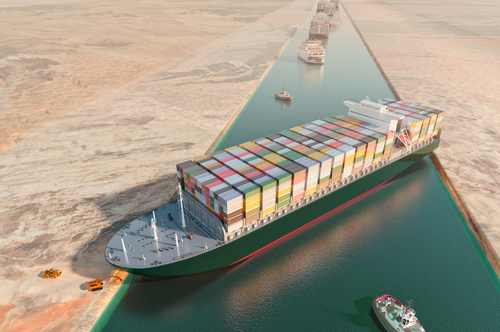Ever Given, the container ship which blocked the Suez Canal for six days, has had rippling effects on the ocean freight market.
Although the blockage came to an end on March 29 due to a combined effort of salvage teams, dredging and tug boats, the event continues to incite both conversation and change within the industry.
Not only did the 20,000 teu, 400 meter-long container ship create a traffic jam of hundreds of boats for six days in one of the world’s busiest shipping corridors, but the incident has led to fuel price fluctuations, short term booking suspensions by companies such as Maersk, and new safety precautions to prevent a similar event from occurring in the future.
According to JOC, shippers are facing unavoidable supply chain disruptions and equipment shortages in the coming weeks in Europe and Asia as carriers revise port rotations in a struggle to recover lost schedules post-Suez.
The Suez Canal closure happened just as the container shipping was already severely stretched by a surge in demand in the second half of 2020 that has continued into this year. This has resulted in “severe port congestion on the US West Coast, and at other major ports, and compounded an already existing shortage of containers in key export markets.”
Furthermore, the Ever Given incident has sparked conversation about whether the growing size of container ships has gone too far, as a single vessel’s ability to cause such a massive interference has prompted the sentiment that some container ships have “simply become too large.”
According to Evangelos Boulougouris, professor of naval architecture, ocean and marine engineering at the University of Strathclyde, the accident “will result in a new wave of precautions to make megaships safer” and “prompt the shipping industry to reflect on whether such gigantic vessels actually do more harm than good.”
Boulougouris notes that container ships have continued to increase in size for decades to carry more and more containers per voyage. According to analysis from Allianz, the number of 20-foot containers that ships can carry has increased by a whopping 1,500 percent over the past 50 years.
In the past 15 years, around 133 ultra large container vessels – including the Ever Given – have been launched with a carrying capacity of between 18,000 and 24,000 containers. These megaships are attractive to international shipping firms due to the economies of scale they provide; using one ship instead of two to carry the same load saves fuel and significantly reduces the cost of transportation per container.
However, operating these megaships in confined waterways has proven to be difficult, as Ever Given has demonstrated. When these huge ships are stacked high with containers, as it can cause the vessels to catch the wind and become even harder to control, which may have played a role in the Ever Given’s grounding. These ships may also be prone to losing containers overboard when caught in a storm on open seas.
“Seeing as the consequences of the Ever Given’s accident were so severe,” writes Boulougouris, “new maritime safety measures will rightly be put in place to avoid a similar incident happening in the future, such as ship design changes, better pilot training, the use of tug boats as canal escorts, autonomous guidance systems, and the widening of waterways.”


